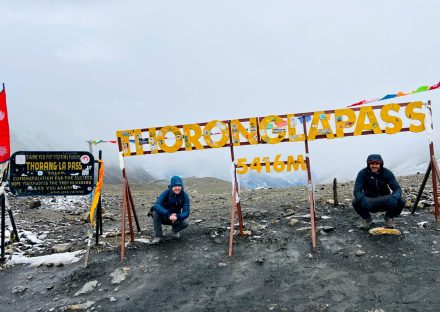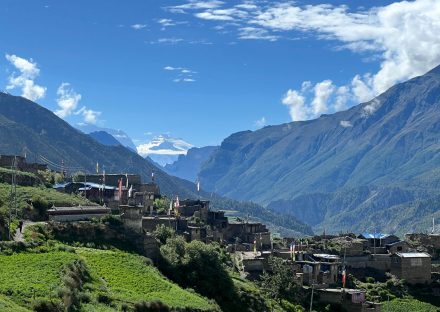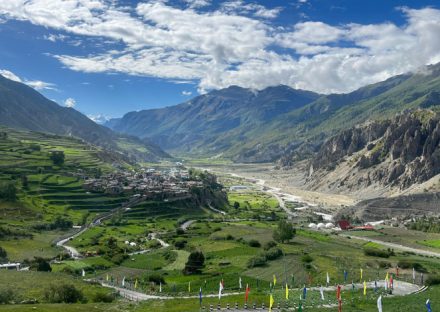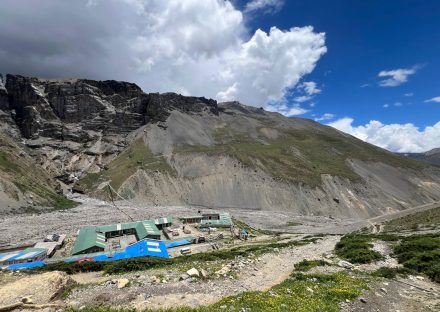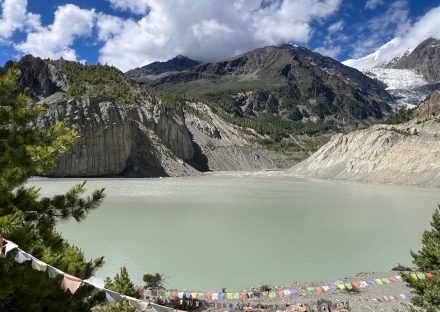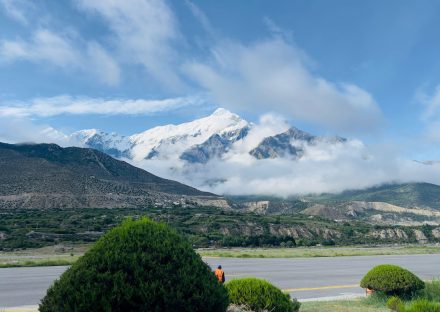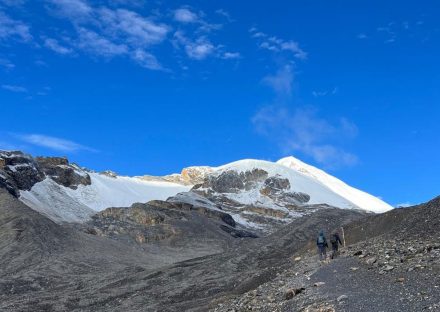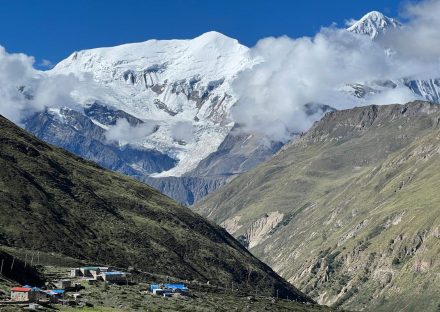
Trip overview
Short Annapurna Circuit Trek
The Short Annapurna Circuit Trek 9 days offers one of Nepal’s most scenic and culturally rich trekking experiences, all within a shorter timeframe. Located in the Annapurna region of central Nepal, this trek takes you through diverse landscapes, from lush valleys to arid high-altitude deserts. Unlike the traditional 12-15 day route, or skip the Tilicho lake this shortened 9 days version packs in the best highlights — including Thorong La Pass, Manang Valley, and Muktinath Temple. Perfect for trekkers with limited time, this adventure provides breathtaking views of the Annapurna and Dhaulagiri ranges, while immersing you in the heart of the Himalayas. It’s also one of the most popular and rewarding trekking trails in Nepal, known for its rich cultural encounters and dramatic mountain scenery.
Trek Highlights
- Thorong La Pass (5,416m): The ultimate goal and a bucket-list experience for any trekker.
- Manang Village: A culturally rich town offering stunning scenery and high-altitude hospitality.
- Muktinath Temple: A sacred site for both Hindus and Buddhists, located in the Mustang region.
- Scenic Variety: From lush forests and rice terraces to arid alpine deserts.
- Panoramic Views: Annapurna I, II, III, IV, Dhaulagiri, Tilicho Peak, and Gangapurna.
- Lakes: Gangapurna Lake and the emerald-hued Green Lake.
- Wildlife: Possible sightings of Himalayan blue sheep, yaks, snow leopards (rare), lammergeiers, Himalayan griffon vultures, and marmots.
Best Seasons for Short Annapurna Circuit Trek
Spring (March to May) brings blooming rhododendrons, lush forests, and vibrant landscapes. The temperatures are mild, and the days are longer, making it one of the most popular and picturesque times to trek.
Autumn (September to November) offers crisp mountain air, stable weather, and crystal-clear visibility. With post-monsoon freshness and less cloud cover, this season provides the best views of the Annapurna and Dhaulagiri ranges.
Winter (December to February) is also possible for trekking, especially in the lower sections of the circuit. However, heavy snowfall may block Thorong La Pass, making it risky to cross. It’s quieter and offers serene snow-covered landscapes, but proper winter gear and flexibility in plans are essential.
Monsoon (June to August) is generally not recommended due to heavy rainfall, slippery trails, and landslides in many areas. However, the Monsoon trek is perfect for Manang valley and Mustang region. As this regions are knows rain-shadow regions in Nepal, which receive much less rain. For those who don’t mind occasional showers and prefer to avoid crowds, monsoon offers a quieter and greener experience with unique mountain atmospheres with blooming flowers.
Local Culture and Etiquette
Respecting local traditions enhances the depth of your short Annapurna Circuit Trek experience. The route winds through villages inhabited by Gurung, Thakali, and Tibetan-influenced communities, each with its own distinct culture, language, and spiritual beliefs.
- Always ask permission before taking photos, especially in monasteries or of locals.
- Dress modestly out of respect, particularly in rural or sacred areas.
- When you come across chortens (stupas), mani walls, or prayer wheels, always walk clockwise around them — a gesture of spiritual respect.
- In monasteries or local homes, remove your shoes before entering.
- Showing gratitude by joining palms together and saying “Namaste” goes a long way in creating warm and respectful connections.
- Avoid public displays of affection, which are frowned upon in conservative areas.
- Support local teahouses and handicrafts to contribute to the local economy and promote sustainable tourism.
Engaging with the culture — whether by trying local foods, listening to traditional stories, or learning simple Nepali phrases — adds unforgettable meaning to your trek.
Flora and Fauna Along the Annapurna Circuit
The short Annapurna Circuit trek 9 days features diverse wildlife and plant life across its changing landscapes. You may see Himalayan blue sheep (bharal) on rocky cliffs, marmots in alpine meadows, and yaks grazing in high pastures. Rarely, elusive snow leopards appear in remote areas. Other animals include Himalayan thar, musk deer, and goral. Birdlife is rich with lammergeiers, Himalayan griffon vultures, Himalayan monals (Nepal’s national bird), snow pigeons, choughs, and pheasants.
Vegetation varies with altitude: rhododendrons bloom in spring at lower and mid elevations, while juniper and pine forests dominate higher regions like Upper Pisang. Lower areas near Dharapani have bamboo and oak forests. Alpine meadows burst with edelweiss and blue poppies in spring and early summer. High pastures grow medicinal herbs such as yarsagumba (cordyceps). Near villages like Manang and Braga, you’ll find fields of buckwheat and barley. This rich flora and fauna add depth and beauty to the trekking experience.
Why Choose the Short Annapurna Circuit Trek 9 days ?
The classic Annapurna Circuit remains a legendary trekking route, but not everyone has the time to commit to nearly three weeks in the mountains. That’s where the short Annapurna Circuit trek 9 days shines. It trims down the days without cutting out the most iconic sections. You still trek through alpine landscapes, high mountain passes, and centuries-old villages, but you avoid the long walk from Besisahar to Manang by starting the trek closer to the core of the route.
This short Annapurna circuit trek version maintains the spirit of the full circuit. You walk through diverse terrains, from lush green forests to arid high-altitude zones. Each day brings new landscapes and new cultures. It’s an intense, fulfilling experience designed for time-conscious adventurers.
Why Short Annapurna Circuit Trek 9 days with Us?
- Experienced Local Guides with deep knowledge of the region.
- Customized Itineraries to match your time and interests.
- Transparent Pricing with no hidden costs.
- Strong Focus on Safety, permits, and logistics.
- Eco-Friendly Practices supporting local communities.
- Authentic Cultural Experiences along the trail.
- 24/7 Support before and during your trek.
Trek smarter, safer, and deeper into Nepal’s beauty with a team that truly cares.
The Short Annapurna Circuit Trek 9 days combines mountain views, wildlife, flora, and culture in a compact journey. Whether you’re an experienced hiker or a fit beginner, this trek rewards you with epic views, unique culture, and a deep sense of achievement — all without needing three weeks off your schedule.
If you’re seeking a high-altitude trek that combines beauty, challenge, and culture — all within a short period — this is it. The short Annapurna Circuit trek 9 days is proof that even a condensed adventure can be a life-changing journey.
Itinerary
Adventure begins with an early morning departure from Kathmandu, heading west on the Prithvi Highway. The drive to Chame covers approximately 230 kilometers and takes 9 to 11 hours, depending on traffic and road conditions. The first section of the drive to Besisahar (760m) is smooth and paved, passing through vibrant towns, lush river valleys, and terraced farmland. From Besisahar, the road becomes rough and off-road vehicles are required to continue. The journey follows the Marsyangdi River, gradually gaining elevation and offering glimpses of waterfalls, pine forests, and towering cliffs. As you approach Chame, the air becomes crisper, and snowcapped peaks begin to appear in the distance. Chame, the district headquarters of Manang, is a small but lively town with basic lodges, teahouses, and shops. You’ll spend the night here to rest and prepare for your trek.
After breakfast, the trek begins along the narrow Marsyangdi Valley, with towering rocky cliffs and dense pine forests lining the trail. The well-maintained path takes you through the small villages of Telekhu and Bhratang. One of the highlights of today’s trek is Paungda Danda, a massive curved rock face rising 1,500 meters above the river. The trail then crosses a suspension bridge and gradually ascends through pine and fir forests to Dhikur Pokhari, where you can stop for lunch. From here, the path climbs steadily toward Upper Pisang, a picturesque village perched on a ridge with stunning panoramic views of Annapurna II (7,937m) and Annapurna IV (7,525m). The traditional stone houses, prayer flags, and monasteries give Upper Pisang a strong Tibetan Buddhist ambiance. This elevated location is also ideal for acclimatization.
Today’s trek is both scenic and strenuous, lasting 6 to 7 hours as you take the upper route through Ghyaru and Ngawal—a path known for its unmatched mountain views and cultural immersion. From Upper Pisang, the trail climbs steeply toward Ghyaru (3,670m), offering breathtaking views of Annapurna II, III, IV, Gangapurna, and Tilicho Peak. The stone-built village of Ghyaru is a great place for a tea break and photography. Continuing along the high ridge, you reach Ngawal, another traditional Tibetan-style village with flat-roofed houses and mani walls. After lunch, the trail gradually descends toward the wide, arid valley of Manang, passing through ancient chortens and scattered juniper trees. Before entering Manang, you can visit the 500-year-old Braga Monastery, one of the oldest and most significant religious sites in the region. Manang is a relatively developed trekking village with teahouses, bakeries, small shops, and even an altitude clinic.
Spending an acclimatization day in Manang is essential to adjust to the higher altitudes and reduce the risk of acute mountain sickness (AMS). There are several hiking options to aid acclimatization. A popular short trek is to Gangapurna Lake and the Glacier Viewpoint, which offers close-up views of the glacier and the turquoise glacial lake below Gangapurna (7,455m). For those seeking a more challenging climb, a day hike to Ice Lake (Kicho Tal) at over 4,600 meters is an excellent option. This hike takes about 6 to 7 hours round-trip and provides a perfect combination of altitude gain and dramatic scenery. In the afternoon, you can explore Manang village, enjoy fresh pastries at a German bakery, or attend the daily altitude briefing at the Himalayan Rescue Association office, where you can learn about symptoms and prevention of altitude sickness.
After a restful day, the trek continues with a moderate 4 to 5-hour ascent to Churi Ledar. Leaving Manang behind, the trail climbs steadily past the last line of trees and into the alpine desert landscape. You’ll pass through the small settlement of Yak Kharka (4,000m), which is a common spot for lunch and a short break. As you walk along this barren terrain, keep an eye out for Himalayan blue sheep and yaks grazing on the slopes. The altitude gain is noticeable, so it’s important to pace yourself and stay hydrated. Churi Ledar is a small outpost with a few basic teahouses that offer warm meals and cozy sleeping quarters. Nights are colder at this elevation, and the air is thinner, so it’s recommended to rest early and stay warm.
This is a relatively short trekking day, taking about 3 to 4 hours, but it's an important step in acclimatizing before crossing Thorong La. The trail begins with a gradual ascent along the mountainside, followed by a careful crossing of a landslide-prone area. Trekking poles are helpful for stability here. After crossing the Marsyangdi River via a wooden bridge, the trail ascends steadily to Thorong Phedi, the last major stop before the pass. You’ll arrive by midday, allowing plenty of time to rest, rehydrate, and mentally prepare for the next day’s early and demanding climb. Some trekkers choose to ascend further to High Camp (4,880m), but this depends on your physical condition and how well you’ve acclimatized. Overnight at Thorong Phedi.
This is the most challenging and rewarding day of the trek. Wake up around 3:30–4:00 AM and begin the gradual but steep climb to Thorong La Pass, one of the world’s highest trekking passes at 5,416 meters. The trail is well-marked but requires endurance and mental strength. It typically takes 4 to 6 hours to reach the top, depending on your pace and weather conditions. At the summit, you'll be rewarded with panoramic views of Dhaulagiri (8,167m) and the surrounding Himalayan giants, as well as fluttering prayer flags marking the accomplishment. After a brief rest and photo break, begin the long descent toward Muktinath, which takes another 4 to 5 hours. The terrain is rocky, and the descent can be tough on the knees, so trekking poles are highly recommended. Muktinath is a revered pilgrimage site for both Hindus and Buddhists, home to the Muktinath Temple and 108 sacred water spouts. Spend the night here in one of the many comfortable teahouses.
After breakfast, your journey continues by vehicle as you descend from the high mountains to the lakeside city of Pokhara. You have two main options: take a jeep all the way from Muktinath to Pokhara, which takes around 8 to 10 hours depending on road conditions, or drive a shorter distance to Jomsom and take a scenic flight to Pokhara (weather permitting). The drive passes through Kagbeni, a medieval village with traditional mud houses, and Marpha, known for its apple orchards and local brandy. You’ll also witness the incredible depths of the Kali Gandaki Gorge, one of the deepest in the world. After the long journey, reaching Pokhara feels like arriving in paradise—lush, green, and peaceful. Spend the evening relaxing by Phewa Lake, enjoying a hot shower, delicious meal, and reflecting on your Himalayan adventure.
After a relaxing night in Pokhara, you’ll begin your return journey to Kathmandu by road. The drive covers approximately 200 kilometers and takes 6 to 8 hours, depending on traffic and road conditions. The route follows the Prithvi Highway, tracing the Trishuli River for much of the way and offering beautiful views of river valleys, terraced farmland, and hillside villages. You can choose between a tourist bus, private jeep, or local bus depending on your comfort preference and budget. Along the way, you’ll stop for lunch at one of the many roadside restaurants serving traditional Nepali cuisine. As you get closer to the Kathmandu Valley, you’ll notice the landscape change from rural hills to the bustling cityscape. Upon arrival in Kathmandu, you’ll be transferred to your hotel, where you can unwind, freshen up, and reflect on your incredible Himalayan journey. In the evening, consider celebrating your successful trek with a farewell dinner in Thamel or a cultural restaurant featuring Nepali music and dance.
Included
- Kathmandu to Besisahar by local bus, followed by a shared jeep transfer to Chame. (A private jeep can be arranged upon request for an additional cost of USD 250.)
- Muktinath to Pokhara by shared jeep or public bus. (A private jeep option is available at an extra cost of USD 200.)
- Pokhara to Kathmandu by tourist bus.
- One night in a clean lakeside hotel in Pokhara on a bed and breakfast (BB) basis.
- Annapurna Conservation Area Permit (ACAP) and TIMS card (Trekker's Information Management System).
- Three meals a day during the trek (breakfast, lunch, and dinner) with a wide selection of Italian, Chinese, Nepali, Indian, and European dishes from the menu.
- Seasonal fresh fruits served after dinner.
- Clean teahouse/lodge accommodation throughout the trek.
- Licensed and experienced English-speaking trekking guide, well-acquainted with the region.
- One porter for every two to three trekkers. (Note: Solo trekkers requiring a porter will incur an additional charge.)
- Guide and porter’s wages, meals, lodging, and insurance fully covered.
- Kitbag to store your belongings during the trek.
- Warm sleeping bag suitable for temperatures down to -25°C.
- All necessary paperwork, government taxes, and local fees.
- Certificate of appreciation from Nepal Wilderness Trekking upon successful trek completion.
Not Included
- International airfare to and from Nepal.
- Nepal entry visa fees upon arrival at Tribhuvan International Airport (15 days: approx. $30; 30 days: approx. $50).
- Accommodation and meals in Kathmandu before and after the trek.
- Lunch and dinner in Pokhara (only breakfast is included).
- Personal trekking gear and clothing suitable for cold, high-altitude conditions.
- Emergency helicopter evacuation or high-altitude rescue, which should be covered by your travel insurance.
- All beverages, including soft drinks, alcoholic drinks, and caffeinated items such as Coke and beer.
- Bottled/mineral water, desserts, snacks, hot showers, and laundry services during the trek.
- Tips for the guide and porter (customary but not fixed).
- Any expenses not mentioned under "Cost Includes".
- Additional costs due to unforeseen circumstances such as bad weather, landslides, natural disasters, political unrest, itinerary changes for safety reasons, illness, or strikes.
Join Us Upcoming Trips
Book this trip with us. Here are the upcoming dates. Feel free to share this trip with your friends and family. For custom trips or general inquiries contact us.
| Departure Date | Trip Duration | Price | Status | |
|---|---|---|---|---|
| 03 August, 2025 | 9 Days | $760 | Available | |
| 08 August, 2025 | 9 Days | $760 | Available | |
| 12 August, 2025 | 9 Days | $760 | Available | |
| 16 August, 2025 | 9 Days | $760 | Available | |
| 20 August, 2025 | 9 Days | $760 | Available | |
| 24 August, 2025 | 9 Days | $760 | Available | |
| 28 August, 2025 | 9 Days | $760 | Available | |
| 01 September, 2025 | 9 Days | $760 | Available | |
| 05 September, 2025 | 9 Days | $760 | Available | |
| 09 September, 2025 | 9 Days | $760 | Available | |
| 14 September, 2025 | 9 Days | $760 | Available | |
| 18 September, 2025 | 9 Days | $760 | Available | |
| 22 September, 2025 | 9 Days | $760 | Available | |
| 26 September, 2025 | 9 Days | $760 | Available | |
| 30 September, 2025 | 9 Days | $760 | Available | |
| 05 October, 2025 | 9 Days | $760 | Available | |
| 09 October, 2025 | 9 Days | $760 | Available | |
| 13 October, 2025 | 9 Days | $760 | Available | |
| 17 October, 2025 | 9 Days | $760 | Available | |
| 21 October, 2025 | 9 Days | $760 | Available | |
| 25 October, 2025 | 9 Days | $760 | Available | |
| 29 October, 2025 | 9 Days | $760 | Available | |
| 02 November, 2025 | 9 Days | $760 | Available | |
| 16 November, 2025 | 9 Days | $760 | Available | |
| 20 November, 2025 | 9 Days | $760 | Available | |
| 30 November, 2025 | 9 Days | $760 | Available | |
| 03 December, 2025 | 9 Days | $760 | Available | |
| 09 December, 2025 | 9 Days | $760 | Available | |
| 16 December, 2025 | 9 Days | $760 | Available | |
| 23 December, 2025 | 9 Days | $760 | Available | |
| 30 December, 2025 | 9 Days | $760 | Available |
Useful Info
If the above dates don’t fit your schedule, let us know your preferred dates. We’ll be happy to customize the trip according to your needs and preferences.
Accommodation on the Annapurna Circuit
The Annapurna Circuit is well-equipped with teahouse lodges that provide basic yet comfortable accommodation throughout the trail. Most rooms are twin-sharing and come with simple beds, foam mattresses, pillows, and blankets. However, as the altitude increases, temperatures drop significantly, so carrying a warm sleeping bag is highly recommended for added warmth and comfort.
Bathrooms are usually shared, and facilities can be quite basic. Hot showers are generally available for an additional charge, often using solar or gas-heated water. Charging electronic devices is possible in most lodges but comes at a fee.
Insurance
Travel insurance is essential when trekking the Annapurna Circuit, not just for peace of mind but also as a safety requirement. Your policy must explicitly cover high-altitude trekking, ideally up to 5,500 meters, to ensure you're protected during the ascent to Thorong La Pass.
Key coverage should include emergency helicopter evacuation, medical treatment, hospitalization, and trip delays or cancellations due to weather or other unforeseen events. It's wise to carry digital or printed copies of your insurance documents.
Food on the Trail
Food is widely available at teahouses along the Annapurna Circuit and is usually prepared fresh using local ingredients. Popular meals include dal bhat (a staple combination of rice, lentils, and seasonal vegetables), along with hearty options like noodles, soups, momos, pancakes, and fried or boiled potatoes.
Most teahouses offer vegetarian dishes, which are safer to eat at higher altitudes where proper meat storage can be unreliable. To keep your energy levels up during long hiking days, carrying energy bars or snacks is a smart idea. These are lightweight, convenient, and perfect for quick fuel on the trail. You can also find snacks and chocolate bars for sale at most teahouses, although prices increase with altitude.
Communication
While mobile network coverage is available in many of the lower-altitude villages like Chame, Pisang, and Manang, signal strength becomes weak or unavailable at higher elevations. NTC and Ncell SIM cards can work in some areas, but it's best not to rely solely on mobile service.
Teahouses offer Wi-Fi for an extra fee (usually NPR 300–500), though speeds can be slow and connections unreliable.
Local Currency
The local currency on the Annapurna Circuit is the Nepalese Rupee (NPR), and it’s important to carry enough cash to cover your personal expenses throughout the trek. While ATMs are available in Kathmandu, they become rare and unreliable once you’re on the trail. Some can be found in larger villages like Manang, Jomsom, and Muktinath, but there’s no guarantee they’ll be working when you need them.
Although three meals a day are included in our trekking package, you should still carry extra cash (preferably in small denominations) for drinks, Wi-Fi, hot showers, charging, snacks, and occasional treats. These extras are not covered in the package and can only be paid in NPR. Credit cards and foreign currency are not accepted along the trail
Water – Stay Hydrated the Smart Way
Hydration is crucial on the Annapurna Circuit, especially at higher altitudes. While water is available in villages, it's not always safe to drink untreated. Instead of buying bottled water—which is costly and harmful to the environment—use purification tablets, chlorine drops, or a portable filter.
Many teahouses offer boiled water for a small fee. Carry reusable bottles or a hydration bladder and aim to drink at least 3–4 liters daily to prevent dehydration and reduce the risk of altitude sickness.
Packing List for Short Annapurna Circuit Trek (Essential & Lightweight)
Clothing:
- Base layers (2 sets)Warm fleece or down jacket
- Waterproof jacket & trousers
- Trekking pants (2 pairs)
- Moisture-wicking t-shirts (2–3)
- Warm hat & sun hat
- Gloves (warm & lightweight)
- Buff or neck gaiter
Footwear:
- Trekking boots (broken-in)
- Camp shoes or sandals
- Wool/synthetic socks (3–4 pairs)
Gear:
- Backpack (30–40L)
- Sleeping bag (rated to -10°C)
- Headlamp with extra batteries
- Reusable water bottles (2L total)
- Trekking poles (optional but helpful)
Personal Items:
- Sunglasses (UV-protected)
- Sunscreen & lip balm (SPF 30+)
- Basic toiletries & quick-dry towel
- Personal first-aid kit & medications
- Snacks (nuts, energy bars)
Documents & Misc:
- Passport & trekking permits (ACAP, TIMS)
- Power bank & charging cables
- Lightweight quick-dry towel
- Cash (for tea houses and tips)
Keep it light, porters have a 10–12kg limit per person. For in more details packing list for trekking in Nepal visit here.
Related other Treks in the Annapurna Region
The Annapurna region offers a wide variety of trekking options that can be customized based on your interests, fitness level, and available time. Whether you’re looking for a quick escape or an extended adventure, here are some popular alternatives:
- 12 days Annapurna Circuit Trek with Tilicho Lake: A more adventurous version of the classic circuit that includes a side trip to Tilicho Lake (4,919m) — one of the highest lakes in the world.
- Annapurna Base Camp Trek (5 Days): A shorter yet rewarding trek that takes you straight into the heart of the Annapurna Sanctuary, surrounded by towering Himalayan peaks.
- Mardi Himal Base Camp Trek 4 days from Pokhara to Pokhara: Spectacular close-up views of Machapuchare (Fishtail) and the Annapurna range.
- Ghorepani Poon Hill Trek in 3 -5 days from pokhara to pokhara: Ideal for beginners or those with limited time, this trek offers stunning sunrise views over the Annapurna and Dhaulagiri ranges from Poon Hill (3,210m).
Booking the Short Annapurna Circuit Trek with Nepal Wilderness Trekking is quick and hassle-free. You can contact us directly via WhatsApp at +9779851205116 (Yakub Ghale) and +97749693351 (Himal Ghale). Also can simply click here to send the inquiry we’ll get back to you promptly.
FAQs
-
What is the shortest time to do the Annapurna Circuit?
The shortest version of the Annapurna Circuit can be completed in 8 to 9 days, starting from Chame and ending at Jomsom or Muktinath, often with a flight or drive back to Pokhara. This route includes crossing the Thorong La Pass and skips the lower elevation sections.
-
Which is the easiest trek in Annapurna?
The Ghorepani Poon Hill Trek is considered the easiest in the Annapurna region. It takes around 3 to 5 days and offers beautiful views of Annapurna and Dhaulagiri ranges without reaching high altitudes, making it ideal for beginners or families.
-
Can you do ABC in 5 days?
Yes, it’s possible to complete the Annapurna Base Camp (ABC) Trek in 5 days with a well-planned itinerary, usually starting from Jhinu Danda or Chhomrong and trekking rapidly to ABC and back. However, it requires good fitness and may limit acclimatization time.
-
Can a beginner do Annapurna Circuit?
Yes, a beginner can do the Annapurna Circuit with proper preparation, a slower pace, and enough acclimatization days. Hiring a guide and porter is highly recommended to ensure safety and support, especially when crossing Thorong La Pass (5,416m).



